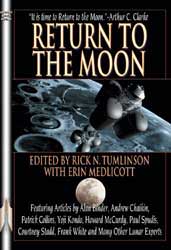
The Apollo program of the 1960’s successfully placed a few military men and one geologist on the Moon’s surface. The goal of the program was to showcase the technology of the US. The result aimed for people around the world to believe that their style of government was better than communism. Since this propaganda event, the US, and indeed the rest of the world has, at best, placed a few more people in low earth orbit. Though a number of programs and concepts were dreamed of and even broadcasted, no funds were ever sent their way. Hence, since the highwater mark of landing on the Moon, people have remained in the relatively safe environs within the Earth’s radiation belt. Only a few robots and probes have gone farther to learn more. With over 30 years accumulated knowledge, many expect that it’s time to use this knowledge and get some return from our investment in space.
The desire to return comes out clear and strong in this book. There are twenty eight articles, each written by a motivated specialist. The common theme addresses the how and why of having people return to the Moon. With so many contributors, particular topics can get quite esoteric. Routine thoughts about launch vehicles are followed by more expansive articles on land ownership, rocket sleds, nanobot proving grounds and conscious evolution. As varied as the topics are, none reside in the realm of science fiction. Each has a sound basis in reason. And each, at least according to the author, would make a valuable contribution to this new program. Judicious editing by Tumlinson and Medlicott keep the articles clear, concise and relevant.
Given that both editors are board members of the Space Frontier Foundation, there is no surprise that the underlying theme of the book is for a greater frontier like attitude to Moon exploration. Given this viewpoint, there’s lots of NASA bashing and suggestions for improvements. The articles aren’t necessarily anti-establishment, the authors just believe that their ideas can improve that which has gone before. But, the authors can be overly optimistic. They seem to forget that during the frontier days there was lots of experimentation together with many accidental and purposeful deaths. This downside is never mentioned. Rather, the typical expectation shown in the articles is for the government to build the transportation infrastructure, as the railways in the old west. Once done, rich people or well funded corporations would use it in the time honoured practise of making profit. Maybe this approach will occur and succeed, maybe it won’t. However, this frontier approach is the only one supported within the book.
By having many different authors and many different angles, each article has its own style and flavour. Like an ice cream stand, there should be something for everyone. Also, the authors make convincing arguments. This leaves the impression is that they’ve argued their cases often and can support their reasoning. This robustness lends credence to individual theories and the underlying theme. Also, the topics flow with little repetition, aside from the berating of NASA though these can easily be skipped over. A preamble presumably written by one of the editors effectively places each article in the flow of the arguments. The editors did however miss a fair number of errors which takes some of the polish off. Nevertheless, if you’re interested in alternative options in getting people working on the Moon, this book has many articles which might strike your fancy.
Government programs are one of the few places where you can get away with spending other people’s money. Fun as it is, everyone from program managers on up the line must be able to substantiate the investment. Rick Tumlinson and Erin Medlicott in their book Return to the Moon bring together articles from many experts to add some options for the US government’s current program to place people again on the Moon and then on to Mars. The many ideas can bring a fresh new perspective to spending money and realizing profit from setting up a work place for humans off of Earth.
Review by Mark Mortimer
Read more reviews online, or purchase a copy from Countdown Creations.
